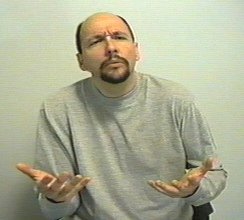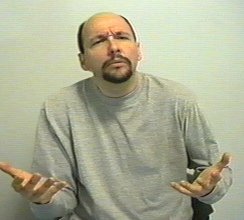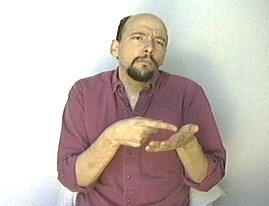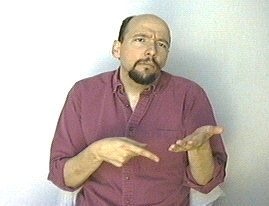For more
information, also see:
"Advanced discussion about the
concept: WHAT."
There is a facial expression that is sometimes called a "wh-q" expression.
It is the type of facial expression you should use when asking questions that have an
answer other than yes or no. Generally these questions start with the
letters "wh" as do the signs WHO, WHAT,
WHEN, WHERE,
WHY...so you
can see why we call this expression a "wh" question expression.
Expressing the concept of
"WHAT" has more to do with your facial expression than your hands. For
example, if I pointed to my watch and used the "wh-q" facial expression it would mean
that I'm asking you "What time is it?" You've probably already
used this sign many times in your life.
WHAT ("huh" version)
In the picture below I'm doing a general gesture for "what" while using the
WHAT facial expression.
Hold your relaxed "5" hands in front of you. Hunch your
shoulders a bit. Jut your head forward a bit.
Use a WH-Q (wh-question)
facial expression. The hands move slightly forward and to the sides.



Here is a variation of the sign "WHAT" that is made by
extending your base hand outward. Starting near the thumb, drag the tip of your
index finger downward, across your palm.
Note: I don't teach this sign in my "ASL" classes. Instead I use the general
version
(above). But I'll show this other version to you so you'll be able to recognize it if you see
it.
This sign (index dragged across the palm) is valid, but is a waste of
time.
Imagine yourself asking an old man (deaf from old age) what time it is.
After he said "Huh? Speak up!" You'd scrunch up your eyebrows and point to
your watch while saying "What time is it?" He'd understand your body
language and would tell you the time.
WHAT: (alternate version)
(not recommended)


Student: Why don't you recommend the alternate version of "what?"
Dr. Bill: It is important to instead learn
to create the meaning of "what" by combining your facial expressions
with your other signs. Using a facial expression and a sign simultaneously
(as in what-TIME?) rather than consecutively using two signs (as in WHAT
TIME?) is more efficient (it is faster and takes less effort).
Optional Reading:
Advanced discussion about the
concept "what."
Also see: "HUH?"